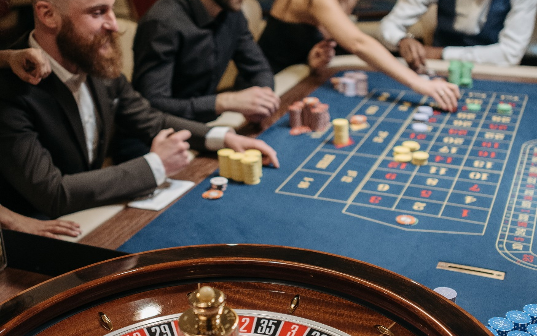Blackjack is one of the most popular casino games due to its simplicity, clarity and speed of the game. But, as in every gambling game, it has its own aspects and features. Read our article about blackjack and its rules and then choose where to play among our best online casinos review.
Basic rules
The main task of the player is to beat the dealer, and not to get 21, as is commonly believed. The game begins with the distribution of cards, for this purpose either a shuffle machine or four decks are used. Each card has its own value in points – two-ten – respectively 2-10, ace – 1 or 11 (11 until the total amount exceeds 21, then – 1), and cards with pictures (jack, queen, king) – 10.
Before the deal, players place bets by placing chips on the appropriate areas of the gaming table. After the first card is dealt, it is forbidden to touch the chips. Then the dealer deals two cards to the player and one card to himself (in the USA, the dealer deals two cards to himself, but one of them is face up). All cards are immediately exposed and seen by both the player and the dealer. After the players have collected the cards, the dealer says: “To myself”, and hands the cards to himself. The general rule of blackjack is that the dealer must always stop as soon as he has 17 points or more, and must take until he reaches that amount, even if all players have lower hands. In some casinos, the rules may vary. For example, the dealer stops if he has an ace and a six (7 or 17). This rule is usually written on the gaming table.
If the player immediately took 21 (ace + ten), then this is blackjack. In this case, the winnings are paid three to one (one and a half times the bet). The exception is the situation when the dealer has an ace, picture or ten – this means the probability that the croupier can take blackjack. Then the player with 21 has a choice – to immediately take the one-to-one payout or wait until the end of the game and get a three-to-two payout if the dealer did not hit blackjack.
If the player does not have a winning combination, he can take another card (say to the dealer: “More” or “Card”) or stay with the current amount of points in his hands. If, having taken a new card, the player scored 21, the dealer no longer asks him and moves on to the next gambler. If the amount of points exceeds 21, it means a loss – the bet goes to the casino and the player waits for the next round.
If the dealer has 21 in the cards during the game, then all players lose. When one of the participants has blackjack, he remains with his bets, if he has not previously taken the bet.
If the dealer and player have an equal number of points, everyone stays with their bets without winning or losing.
The cards in the hands of others do not matter to the gambler, since the game is played only against the dealer and the casino.
Online blackjack works in a similar way, which has recently become widespread in the format of live games.
Additional rules.
They may include the following:
Splitting pairs (split) – if the player received two cards of the same value (2-2, 7-7, 10-10, etc.), the dealer may offer to split one hand into two. In this case, you need to make another bet, similar in amount to the first, after which the dealer makes a split and plays as if dealing with two bets or individual players.
Double bet – the player can double the amount of the bet, but receive only one additional card. In some casinos, this is only allowed when the hand has 10 or 11 points. Also, some gambling houses allow you to double your bets in case of a split.
Triple bet – the player can triple and get another card after doubling the bet. This rule is rare.
Blackjack insurance – in some gambling houses, the player can insure the bet if the dealer’s first card is an ace. Insurance means the possibility to bet half of the initial bet on top and get a two-to-one win if the dealer has a blackjack. That is, the player loses the main bet, but wins an additional one, so he stays with his chips.
Side bets
Casinos often try to diversify the process of the game, and the dealer can offer the player additional betting opportunities. The most popular of them are:
Perfect Pair – a bet that the player’s first two cards will be a pair.
Jackpot bet – is played if the player and the dealer get two or more aces on the four cards dealt. The jackpot is paid if there are four aces of the same color.
High-Low 13 – a bet that the sum of the player’s first cards will be less than, greater than or equal to 13.
Bonus bet – is played if the first two cards of the gambler are of the same suit.
Types of the game
Basic (American) – the dealer has one open card and one hidden card. When an ace or ten is revealed, the dealer looks at the hidden card, and if it has a blackjack, the casino wins.
European – the dealer takes the second card only after the deal to the players, if the croupier got blackjack, then all players are returned additional bets, except for insurance.
Blackjack strategies
There are several cases in history when mathematically gifted players have consistently won at blackjack thanks to card counting and statistics. The account was based on the fact that the deal was previously made from one or more decks (shoe) and the played cards were not returned to them, and the deck was not shuffled. And thanks to this, the gambler calculated the cards used and predicted the probability that his hand would win against the dealer. The first such player was Edward Thorpe, who brought his theory to perfection, which quickly found himself among the unwanted guests of the casino, although there was no fraud in his actions – only the use of mathematics, statistics and forecasting.
There was also a group of students from the Massachusetts Institute of Technology, whose technique of counting cards allowed them to win at gambling houses for a long time. And before the security services of various casinos learned how to calculate players, they managed to win about $5-10 million.
Nowadays, these tactics will not help the player much, because casinos have increased the number of decks (four or more) or started using shuffle machines, to which the played cards are returned. In this case, it becomes quite difficult to calculate the probability of winning.




